
© Christopher Duggan. (Click image for larger version)
Jessica Lang Dance
Lyric Pieces, The Calling, Thousand Yard Stare, This Thing Called Love
★★★★★
San Francisco, Yerba Buena Center for the Arts
28 February 2019
www.jessicalangdance.com
sfperformances.org
www.ybca.org
SF Performances’ three-part dance series just launched this week at Yerba Buena Center for the Arts and it’s a very exciting slate: Rosie Kay Dance Company arrives in April and Dorrance Dance in May. But up first was New York-based Jessica Lang Dance, who in this, their San Francisco debut, absolutely stunned with a stellar four-work program. From the first light cue to the final blackout, the troupe commanded the space with technical ferocity, penetrating narrative themes and clarity of vision. It was a marvellous showcase of Artistic Director Jessica Lang’s choreographic voice and the nine-member ensemble’s extraordinary talent. And yet, a bittersweet note permeated the air, as the company will be disbanding later this spring.
Lyric Pieces (2012) is certainly true to its title – a collection of pleasing, movement episodes. Set to ten Edvard Grieg compositions (beautifully interpreted by pianist Sarah Cahill), Pieces is a tonal novella, in which Lang unpacks an array of states and spirits through graceful, balletic vocabulary. Buoyant jumps and quick footwork communicated a light and joyful air; swirling arms and shifting directions, an excited abandon. Cannoned sequences and stately walks provided a sophisticated grandeur, while a social dance portion had a mischievous, cheeky nature. Kana Kimura and Thomas Ragland’s pas de deux was filled with desperate passion and whenever Jammie Walker was onstage, his technical prowess both awed and astonished. But Pieces wasn’t just evocative dancing and lovely music. Throughout the work, the cast of eight maneuvered large black accordion-like structures, creating different shapes and landscapes during each dance chapter. Such a masterful trope for Pieces. Changeable components were an apt complement for a dance that similarly shifted from tone to tone. And because the dancers were moving them, the structures felt enmeshed in the scene; part of the cast in their own right, acting not only as design backdrops, but as dance partners, walking surfaces and points of balance.

© Sharen Bradford. (Click image for larger version)
While short in duration, 2006’s The Calling, a solo danced by Kimura, was high on visual impact. A distinctly spiritual atmosphere pervaded Calling’s first moments. The curtain rose, revealing Kimura in a breathtaking white dress, the skirt pooled in a huge circle (designed by Elena Comendador with concept by Lang). The music, by Trio Mediaeval, had an uplifting chant-like quality, and Kimura’s arms soared towards the heavens. While that sense of reflective contemplation underscored the piece, as Calling went on, another layer was added, one that spoke to the relationship between restriction and expanse. The dress’ volume and length meant that particular movements were not really possible, specifically those of the legs and feet. To relay that frustration and limitation, Lang imbued the choreography with dramatic contractions. At the same time, with the lower body de-emphasized, there was a freeing of the torso, a chance to experiment and realize its fullness, agility and range. Calling allowed containment and scope in the same moment, which felt quite profound.
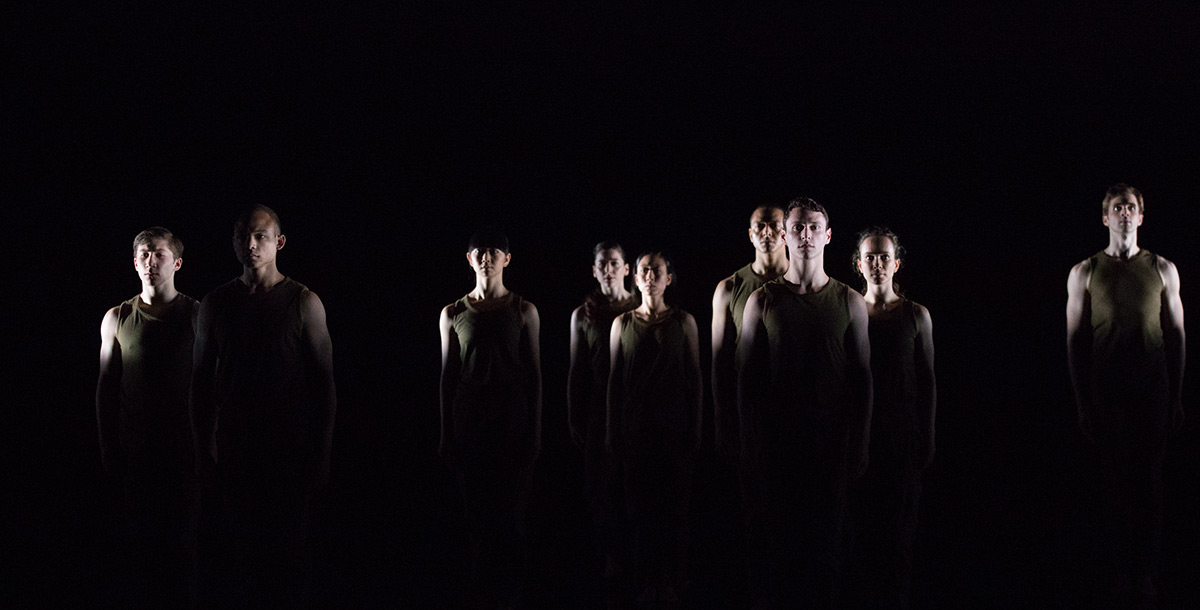
© Rosalie O’Connor. (Click image for larger version)
Next came a powerful contemporary full-company work, 2016’s Thousand Yard Stare, a phrase that evokes a soldier’s distant and dissociated eye having witnessed the ravages and inhumanity of war. This empty expression pervades Stare, the nine dancers cycling through a potent collage of movement phrases with an unchanging, unflinching stoicism. But Lang digs much deeper and mines the horrors of trauma, by showing it as both a collective and individual experience. As a group, the nine united in unforgiving, persistent sequences for which escape seemed impossible: precise footwork patterns, flinging arms and circling heads alongside full throttle moments of jumping, diving, rolling and crawling. And their costumes, by Bradon McDonald, were identical khaki green. Or so it would seem. As the cast turned to face upstage, they revealed the backs of their shirts, which had distinct designs. Yes, they were a collective, but there were also individuals. Individuals who needed to share their unique reality. To that end, they would periodically break out of the group on their own – palms pushing the space away; hands covering heads; bodies exhaustedly collapsing to the ground. And as Stare came to its conclusion, we were left with a fitting image for these two states of being: eight of the cast together on one side of the stage and one soloist, alone on the other.
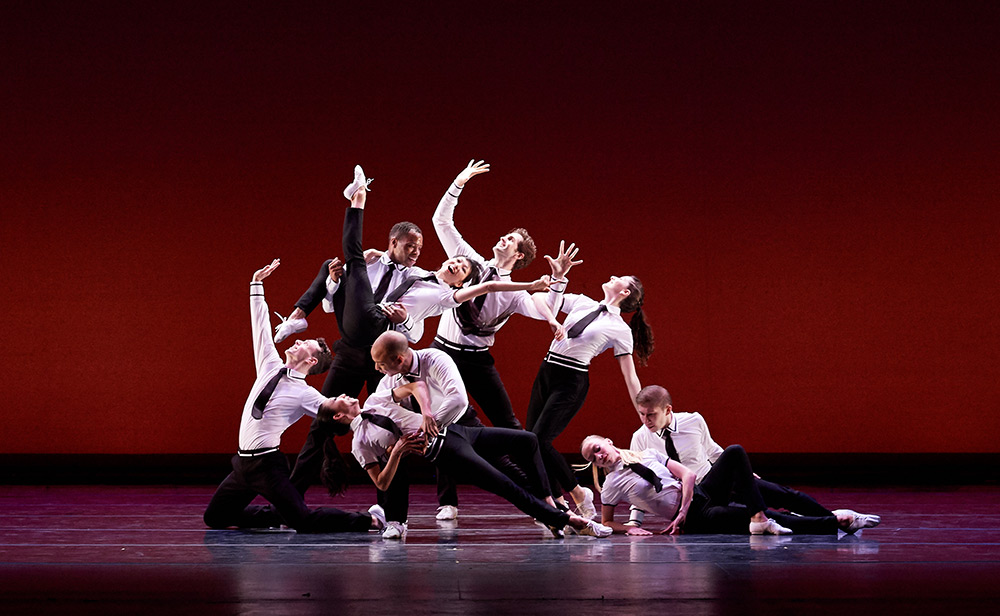
© Rachel Neville. (Click image for larger version)
I’ve seen many pieces that honor a particular music icon, both classical and popular. Some work, some don’t. Lang’s This Thing Called Love, an homage to Tony Bennett, which premiered last year, is a winner. It had it all. Phenomenal dancing by the entire company. Movement that was high energy, ever changing and dynamic. Jazz dance, old-school tap, swing and Broadway hoofing. Large jumps in second were countered by smooth grapevines and whimsical knee pops. Lyrical duets were steeped in the long/low extensions and supple backbends of ballroom. But the main reason why Love worked so well was that it didn’t take itself too seriously. Love demonstrated that technical and choreographic rigor can also be such fun. And the dancers looked like they were having an absolute blast.









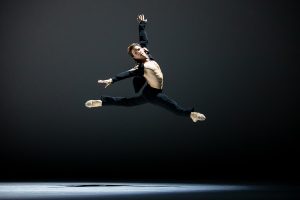
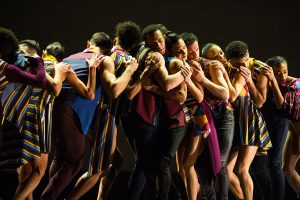


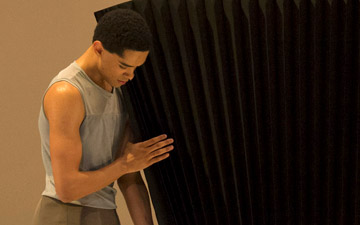

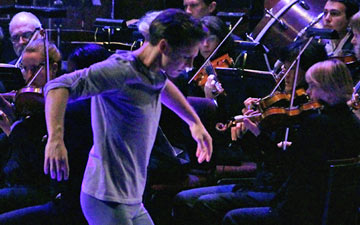

You must be logged in to post a comment.